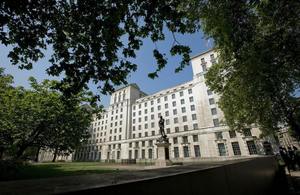Battle of Britain spirit flies on in the RAF
Group Captain Billy Drake, Battle of Britain Hurricane pilot, points to the name badge on Typhoon pilot Flight Lieutenant Rich Walton’s flying…

Group Captain Billy Drake, Battle of Britain Hurricane pilot, points to the name badge on Typhoon pilot Flight Lieutenant Rich Walton’s flying suit, the embroidered lettering identifying him as ‘Wally’:
So you fly around with that on do you?” he says.
The veteran’s rhetorical question elicits smiles from his young audience.
Billy (as he likes to be known) is sitting in the back of a Transit van at Biggin Hill Airport, on the site of the famous Battle of Britain RAF station, talking to two Typhoon display pilots who are sitting in the grass staring up at him like spellbound kids. They are discussing a shared passion - flying fighters.
When 92-year-old Billy flew Hurricanes in the Second World War he would be smartly dressed in collar and tie. Today’s Typhoon pilots depend on hi-tech flying suits to keep them breathing through manoeuvres that can exert up to 9Gs of pressure on their lungs and blood circulation system.
Comparing the technology-laden Typhoon and its mouth-watering menu of weaponry with the prop-driven Hurricanes, equipped with machine guns and with a top speed of around 350mph (560km/h), would be banal. The men and their experiences are more fascinating.
In 1937, Billy took on a short service commission in the RAF after seeing an advertisement in his favourite magazine, Aeroplane. Raised and educated in Switzerland, Billy’s English was poor:
I was so bloody ignorant I didn’t think they’d want me,” he says. “My parents wanted me to be a doctor, but I just wanted to fly planes.
Same here,” chorused Flight Lieutenant Walton and Flight Lieutenant Tim Clement. “We joined up because we wanted to fly, and the best aircraft are military. You don’t know why you want to, you just do. I was sponsored by the RAF though university,” said Flight Lieutenant Walton.
No such mollycoddling for Billy:
It’s a very professional organisation now, as against a lot of playboys, which is what we were. We had nobody to train us how to fly these aircraft in a warlike manner.
The four squadrons that went out to France in Hurricanes were the first to meet the enemy. We had to learn for ourselves as we went along, then go back and tell our senior officers what it was all about. And they had to listen.
A lot of the tactics we use today are the same,” says Flight Lieutenant Walton. “Nothing’s changed in terms of fighter versus fighter. We have better ways of communicating these days, and sharing tactics with our allies.
In Billy’s day you couldn’t just pick up the phone and call another squadron and ask them how they are doing things. Also, we do a lot of training on simulators before we get into an aircraft. It takes about four years to actually join a front line squadron.
In Billy’s day, flying could be much more casual:
A chum would land in an aircraft you’d never seen before and you’d ask if you could have a go in it. He’d say, ‘Yeah, this is the fuel system, this is the stalling speed. Can I have a go in yours?’
The Typhoon pilots convulse with giggles. Clearly they love the idea:
I’ll have to ask the boss if I can have a go in his Harrier,” said Flight Lieutenant Walton.
Downtime was important to Billy:
We might be told, ‘You are going to be busy for the next ten days, then you can p*** off to London to relax’. Then a bunch of us would go and see our girlfriends.
Knowing eyebrows are raised. Billy immediately puts them straight:
Our relationship with girls was different, we wouldn’t sleep with them. It just wasn’t done.
But what is asked of these pilots, generations apart, is remarkably similar. The Typhoon controls the UK’s airspace, just as the Spitfires and Hurricanes did. Those who fly them have to be prepared for every eventuality.
Although ground support for troops in Afghanistan is the principal demand on front line crews at the moment, Flight Lieutenants Clement and Walton know threats can change. Billy knows all about that:
I left England as an interceptor pilot, and went out to the desert flying Kittyhawks. I suddenly found we were being used in ground attack so we had to learn to use the aircraft in a new way.
What about the nerves and, let’s face it, the fear? Were they an important element then, and are they now?
One is not frightened; one is apprehensive,” says Billy. “You may be sick as a dog before you start, but you just get stuck in.
Exactly,” agrees Flight Lieutenant Clement. “You have to have a bit of apprehension to work at your best.
Billy is sanguine about dealing with the ultimate price of war:
We never really formed close relationships. They [fellow pilots] were chums, not close friends. You were not emotionally involved with other people. You accepted that they could be shot down, and if they were, bad bloody luck. That’s war. You’d go up to their room and see if there was anything you could borrow.
The simplicity of this statement is unnerving. Were they ‘just a bunch of playboys?’ Of course not. It’s not true of today’s air crews, and it clearly wasn’t true in Billy Drake’s day.
This article by Ian Carr was first published in the August 2010 issue of Defence Focus - the magazine for everyone in Defence.
See Related Links to download a copy of the magazine and for more exclusive features on the Defence Focus Blog.